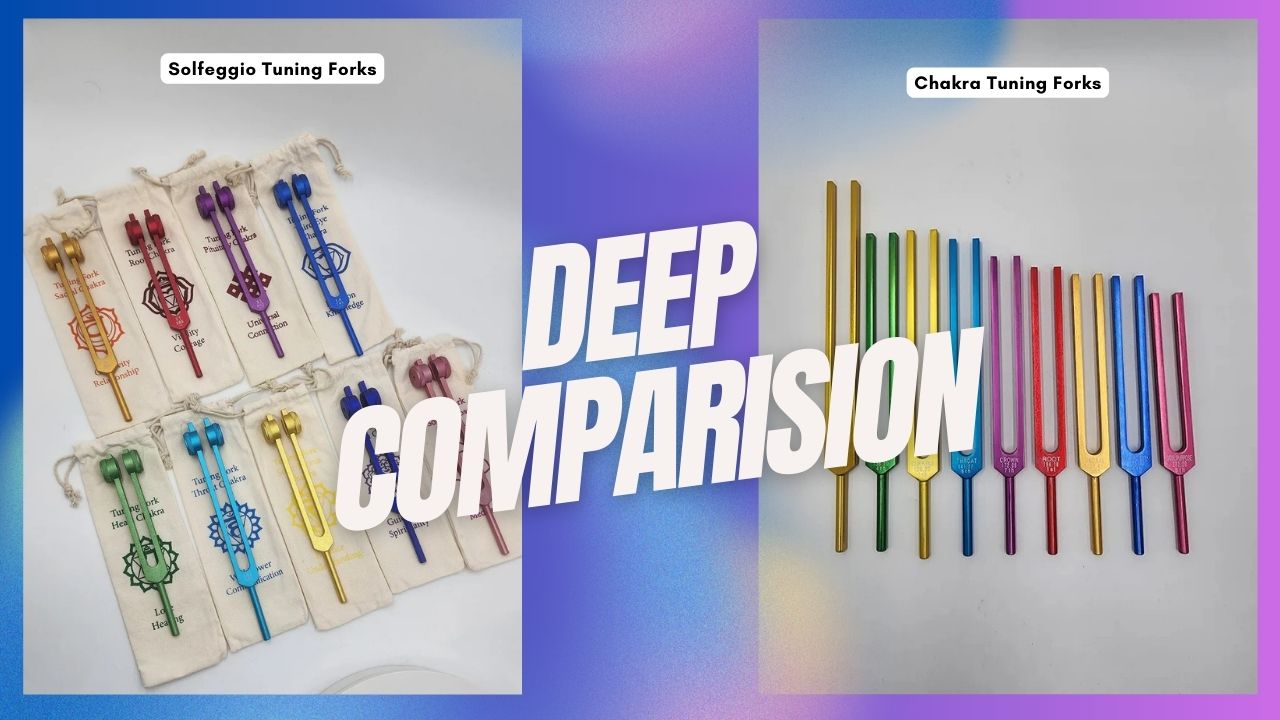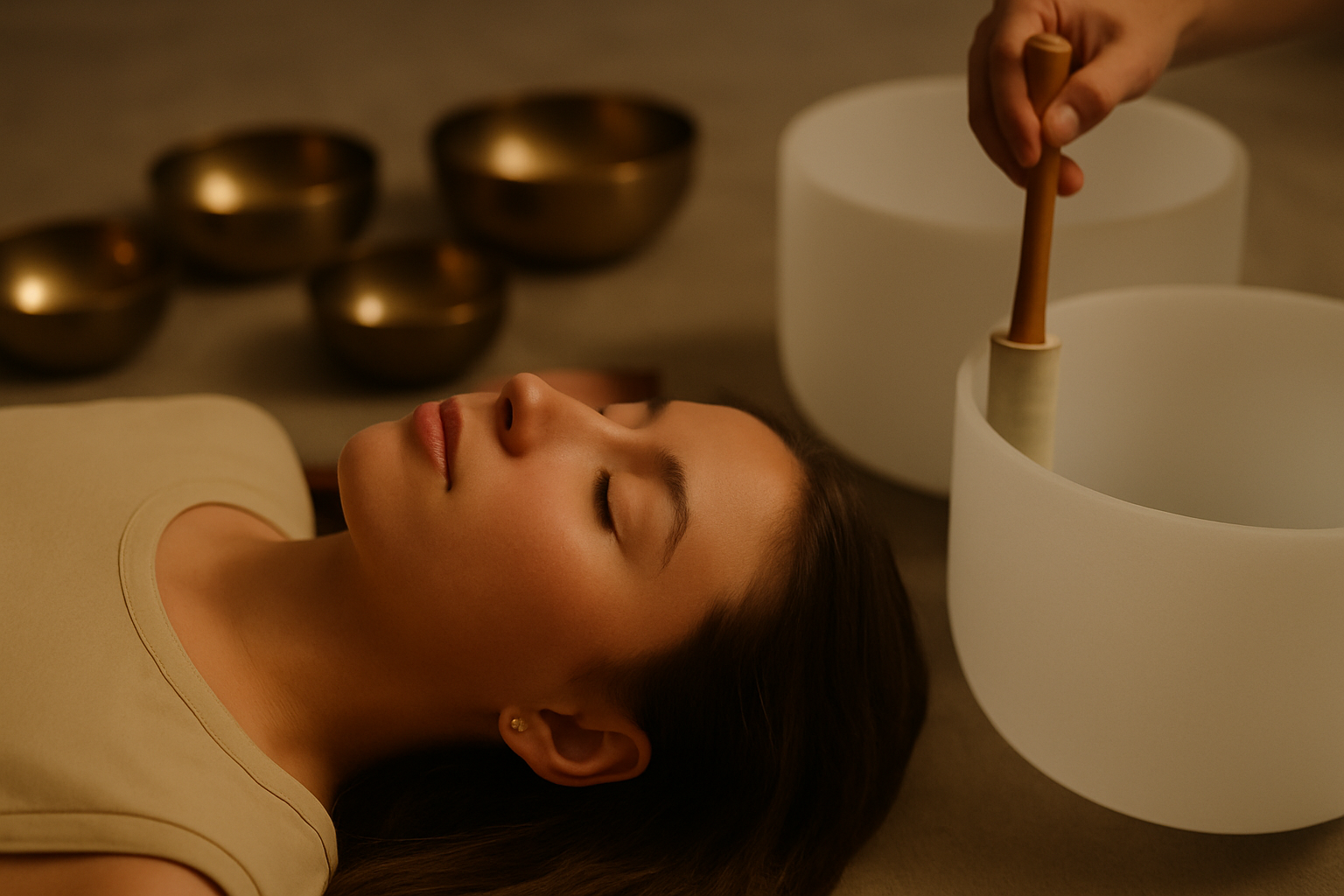In the world of sound healing, one common question keeps coming up: Solfeggio tuning forks vs chakra tuning fork—what’s the difference, and which one is right for you? While both are powerful tools for restoring balance and promoting well-being, they’re based on different frequency systems and offer distinct healing benefits.
The purpose of this comparison is to help you understand how each tuning fork works, what sets them apart, and how to choose the one that best supports your energy healing journey. Read this whole article to know each and every detail about it, so you can make a confident and informed decision.
What Is Solfeggio Tuning Fork?

A Solfeggio tuning fork is a sound healing tool tuned to specific frequencies from the ancient Solfeggio scale, believed to promote physical, emotional, and spiritual healing. These frequencies include tones like 396 Hz (liberating fear), 417 Hz (facilitating change), and 528 Hz (DNA repair and transformation). When struck, the fork emits a pure tone that resonates through the body and energy field, helping to balance chakras, release tension, and restore harmony.
Used in meditation, sound therapy, and holistic healing practices, Solfeggio tuning forks are applied near or on the body to create vibrational shifts. The sound and frequency are thought to influence the body at a cellular level, promoting relaxation and inner peace. While scientific evidence is limited, many users report benefits such as reduced stress, improved focus, and emotional release. These tuning forks are valued for their calming tones and potential to support healing through vibration and resonance.
What Is Chakra Tuning Fork?

A chakra tuning fork is a sound healing tool designed to balance and align the body's seven main energy centers, known as chakras. Each fork is tuned to a specific frequency that corresponds to one of the chakras, from the root (Muladhara) to the crown (Sahasrara). When activated, the fork emits a vibration intended to clear blockages, restore energy flow, and promote emotional and physical well-being.
Practitioners use chakra tuning forks during meditation, energy healing sessions, or bodywork by placing or moving the forks near the corresponding chakra points. The sound vibrations are believed to harmonize the body's energy system, supporting inner balance, mental clarity, and spiritual connection. While scientific validation is still evolving, many individuals find chakra tuning fork therapy calming and revitalizing, making it a popular tool in holistic and integrative wellness practices.
Solfeggio Tuning Fork vs Chakra Tuning Fork - Deep Comparison
1. Origin and Frequency Basis
Solfeggio Tuning Forks:
Derived from the ancient Solfeggio scale, these forks are based on specific mathematical frequencies such as 396 Hz, 417 Hz, 528 Hz, etc. This scale was historically used in Gregorian chants and is believed to have spiritual and healing effects through precise vibrational tuning.
Chakra Tuning Forks:
These are tuned to match the resonant frequencies associated with the body’s seven main chakras. Frequencies can vary depending on the system or tradition (e.g., some use musical notes like C, D, E, F, etc.), often aligning with the Western musical scale rather than ancient scales.
2. Purpose and Focus
Solfeggio Tuning Forks:
Aim to promote spiritual awakening, DNA repair, emotional release, and consciousness expansion. Each frequency is associated with a universal healing property (e.g., 528 Hz for transformation and miracles).
Chakra Tuning Forks:
Focus on restoring balance and energy flow in the chakra system. Each fork targets a specific chakra to clear blockages and harmonize physical, emotional, and spiritual states.
3. Use in Healing Practices
Solfeggio Tuning Forks:
Commonly used in meditative and spiritual practices. Practitioners often use them to shift vibrational patterns or create energetic alignment across the body and mind. The forks may be applied to the body or simply played around the energy field.
Chakra Tuning Forks:
Often used in chakra balancing sessions. Practitioners place or activate the forks near each chakra point to tune and energize that specific center, supporting energy flow and emotional equilibrium.
4. Philosophical and Energetic Roots
Solfeggio Tuning Forks:
Emphasize sacred geometry, numerology, and ancient mysticism. Their frequencies are seen as “divine tones” with intrinsic spiritual significance.
Chakra Tuning Forks:
Rooted in yogic and Eastern traditions, aligning with the chakra system which corresponds to endocrine glands and psycho-emotional states in the body.
5. Scientific and Anecdotal Backing
Solfeggio Tuning Forks:
Largely supported by anecdotal evidence and metaphysical teachings, with limited empirical research. However, users often report transformative emotional and mental effects.
Chakra Tuning Forks:
Also supported mainly by experiential and holistic practices. Some practitioners use biofeedback or kinesiology to measure results, though mainstream science is cautious.
Summary Table
| Aspect | Solfeggio Tuning Forks | Chakra Tuning Forks |
|---|---|---|
| Origin | Ancient Solfeggio scale | Chakra system (Eastern traditions) |
| Frequencies | Fixed sacred frequencies (e.g., 528 Hz) | Varies by chakra (often Western music scale) |
| Focus | Spiritual healing, consciousness, DNA repair | Chakra balancing and energy alignment |
| Usage | Whole-body and energy field work | Direct chakra targeting |
| Roots | Numerology, sacred geometry, mysticism | Yogic philosophy, subtle energy anatomy |
| Scientific Backing | Minimal; mostly anecdotal | Minimal; mostly holistic evidence |
Similarities Between Solfeggio Tuning Fork & Chakra Tuning Fork
| Aspect | Similarity |
|---|---|
| Purpose | Both are used in sound healing to promote physical, emotional, and spiritual balance. |
| Method of Use | Activated by striking and used near or on the body to produce healing vibrations. |
| Energy Work Application | Commonly used in practices like Reiki, meditation, and holistic therapy. |
| Vibrational Healing | Work through vibrational frequencies to influence the body’s energy field. |
| Non-Invasive Therapy | Both provide a gentle, non-invasive approach to healing. |
| Stress Relief | Help reduce stress, induce relaxation, and support emotional release. |
| Holistic Approach | Address well-being on physical, emotional, mental, and spiritual levels. |
| Anecdotal Benefits | Supported by positive user experiences, though scientific research is limited. |
| Complementary Use | Often used together in integrative healing sessions for enhanced results. |
How to Choose the Right Tuning Fork for Your Needs?
Personal Intention and Healing Goals
Identify what you want to achieve—emotional release, chakra balancing, spiritual growth, or physical relaxation. If you’re drawn to energy centers and body-focused healing, chakra tuning forks may suit you best. For spiritual transformation, stress relief, or deep vibrational resonance, Solfeggio tuning forks can be more aligned. Your intention is key to guiding your choice.
Beginner Tips for Working with Tuning Forks
Start with one or two forks that match your primary healing intention. Learn how to activate them properly—using a rubber activator or gently tapping—and hold them near the ears or energy centers. Practice regularly in a calm space, and stay open to observing subtle changes in your mood or energy.
Combining Both Systems for Holistic Wellness
Using both Solfeggio and chakra tuning forks allows a fuller healing experience. Chakra forks align and energize specific areas, while Solfeggio forks support deeper emotional and spiritual shifts. When used together, they create a synergistic effect that balances both the body’s energy system and the broader vibrational field.
Frequently Asked Questions
Question 1: Are Solfeggio Frequencies Scientifically Proven?
Answer: Solfeggio frequencies are not widely backed by mainstream scientific research, but they are supported by anecdotal evidence and spiritual traditions. Many users report positive effects such as deep relaxation, emotional clarity, and energetic balance. While studies on sound therapy are growing, more scientific validation is still needed for Solfeggio-specific claims.
Question 2: Can I Use Tuning Forks at Home Without Training?
Answer: Yes, you can use tuning forks at home safely without formal training. Start with basic techniques like activating the fork and holding it near energy centers or ears. However, learning from books, videos, or workshops can enhance your understanding and effectiveness, especially for therapeutic or chakra-based applications.
Question 3: How Often Should I Use Tuning Forks for Healing?
Answer: Frequency of use depends on your goals. For general relaxation or energy balancing, 2–3 times per week is often beneficial. Daily use is safe and can deepen results over time. Listen to your body—consistency matters more than intensity, and even short sessions can bring noticeable benefits.
Question 4: Can Tuning Forks Be Combined with Other Healing Modalities?
Answer: Yes, tuning forks integrate well with practices like Reiki, massage therapy, meditation, acupuncture, and yoga. Their vibrational energy can enhance the effectiveness of other treatments by helping the body relax, release blockages, and increase receptivity to healing. Many holistic practitioners use them as a complementary tool in their sessions.
Conclusion
In exploring Solfeggio Tuning Fork vs Chakra Tuning Fork, it's clear that both offer unique paths to healing through sound and vibration. Solfeggio forks focus on spiritual transformation and ancient frequencies, while chakra forks target specific energy centers for balance and alignment.
Whether used separately or together, each system supports holistic well-being, helping you restore harmony in body, mind, and spirit. Choosing the right one depends on your personal goals, but integrating both can enhance your healing journey. Let your intention guide you as you discover the power of vibrational therapy in your daily life.





Leave a comment
This site is protected by hCaptcha and the hCaptcha Privacy Policy and Terms of Service apply.